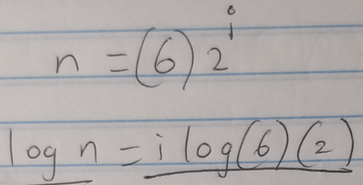nicholaskong100
New member
- Joined
- Aug 1, 2021
- Messages
- 33
We do not know the problem statement of your assignment!
I think you are trying to find an explicit formula for T by looking for a pattern.Is there any critique about each step?


Step 1: Write the recursive functionI think you are trying to find an explicit formula for T by looking for a pattern.
One comment is that I think you need to expand expressions like
View attachment 28958
in order to see the correct pattern.
Another is that these are not equivalent:
View attachment 28959
That probably won't be used in the correct solution, but you do need to learn to be careful with logs.
A thought about the problem itself: Have you considered what happens if n is not a power of 2? I started by calculating T(2), T(3), T(4), and this is instructive. Your final answer is likely to involve something like the greatest-integer function.
One specific question: Can you tell us what steps you were taught to take, so we can understand your approach?
Before I list the 5 steps, the first is a base case and the second is a recursive case of a function,We do not know the problem statement of your assignment!
Please post the exact problem as it was given to you.
You haven't expanded, as I use the term. In particular, your step 3 has an expanded form, which doesn't match your results from step 2.Step 2: Expand the recursive function three times
How is i defined?Step 3: Write the last T(n) in terms of i
What does this refer to? Will we understand when you state the problem fully?Find c and n when claiming the equation is Big O
